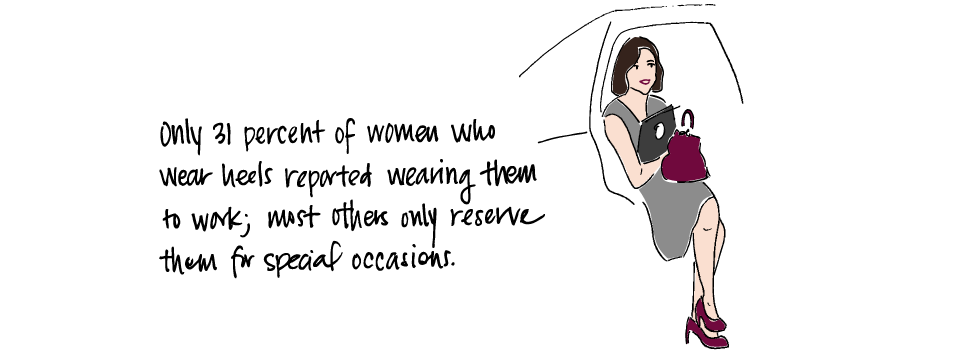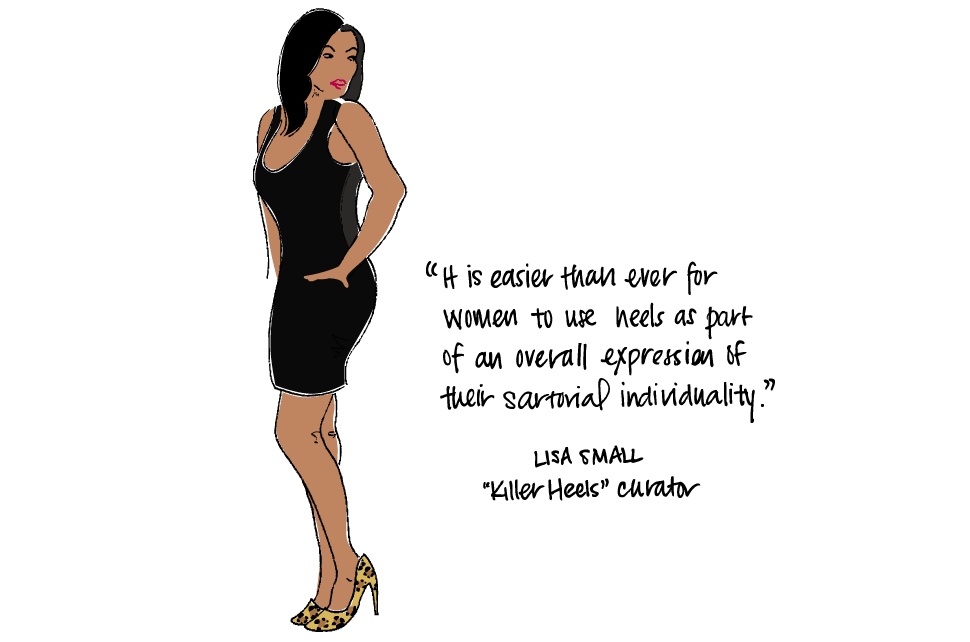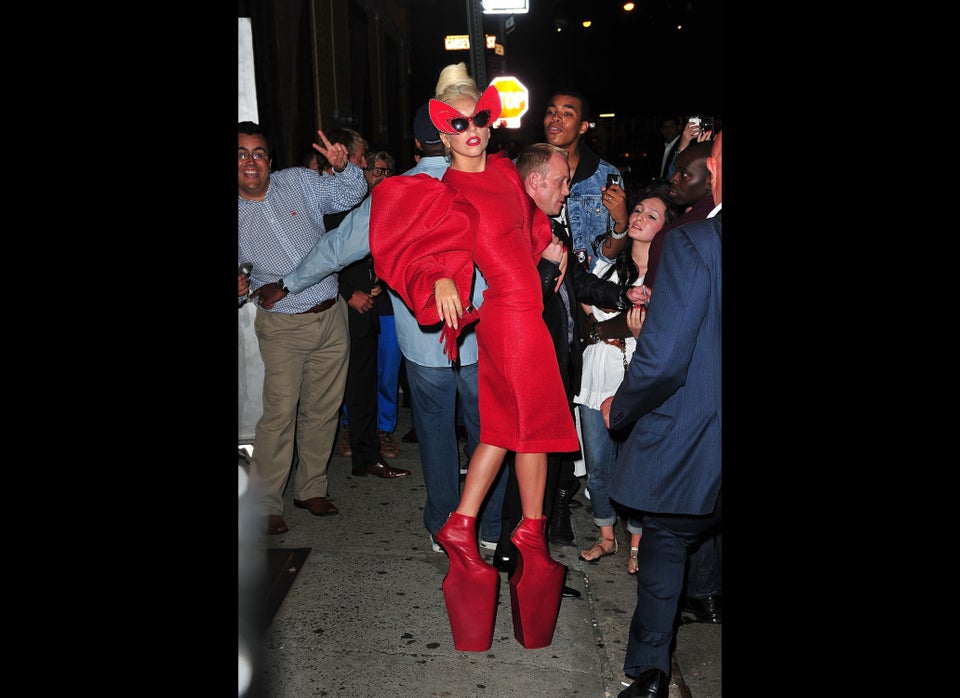You needn’t look beyond Hillary Clinton’s presidential campaign to understand this paradox: the more powerful a woman is, the more we pay attention to her outfits.
In January, The New York Times wrote that Clinton “ended the clothing conversation” by opting for practical, inoffensive looks: black slacks, thigh-length blazers, scoop-necked blouses, and nearly flat shoes. The fact that the piece was considered newsworthy at all indicates that the conversation had not ended, and indeed it hasn’t; pantsuit digs and pantsuit think pieces are slung in equal measure. Meanwhile, Bernie Sanders’s unremarkable sartorial decisions remain, well, un-remarked upon.
Although her shoes aren’t the topic of as much discussion as the rest of her wardrobe, Clinton’s choice to wear flats is a bold assertion of her unbending confidence. The decision to don practical footwear may seem like common sense for someone whose job demands thinking on her feet, but it’s a step away from the rules outlined by power women in pop culture, and on the covers of magazines -- that is, the women who are often perceived of as role models.
If Clinton followed the lead of the power women portrayed in political dramas and sitcoms like “House of Cards” or “Veep,” she would know that elevated heels are still linked with elevated status, comfort be damned.

Some of these shows are more realistic in their portrayal of driven women. Selena Meyer, the strong-willed protagonist on “Veep,” might be the subject of clickity walk-and-talk pans, but the camera follows her home, where she kicks off her heels, exhales, unwinds. Claire Underwood, on the other hand, might as well have her heels welded to the balls of her feet, completing the fusion of her stilettos and her identity.
Megan Garber wrote a piece for The Atlantic about the strangeness of the character’s poorly conceived lifestyle choices, which include walking around her own home in her very high heels. She even seems to sleep in them. “No woman […] has walked around her home in stilettos. No. Woman. Ever,” she wrote. “Heels may lengthen the leg and swagger the walk and do all manner of aesthetically pleasing things to the lower limbs of the human body; they achieve all this, however, by creating in their wearer a step-by-step discomfort.”
That any article of clothing, be it a restrictive bra or an uncomfortable shoe, would need to be cast aside once the wearer is alone, shows that the desire to wear it is linked with how it makes her feel in public, and how she’s publicly perceived. Certainly it shows that the garment is physically uncomfortable, which is why, for the average American woman, the decades-long trend of heel-wearing is tumbling, especially in the workplace. According to the Spine Health Institute, 72 percent of women wear heels “some of the time.” But, on average, heel-wearing dropped 21 percent between 1986 and 2003. Only 31 percent of women who wear heels reported wearing them to work; most others only reserve them for special occasions. This is because heels are proven to put a strain on your body; one-inch heels exert 54 percent less pressure on your feet than three-inch heels, for example.
It is perhaps due to these reasons -- health and general discomfort -- that, in the short history of women’s workplace attire, high heels have not always been worn. Even a non-scientific survey of power women from sitcoms of decades past indicates that expectations in the '60s, '70s and '80s were lower -- at least in terms of heel height.
When a wide-eyed Mary Tyler Moore spun in circles, casting her hat jubilantly into the air at the start of each episode, it was her low-heeled boots that enabled such mobility. Her success as a producer isn’t hindered by her practical fashion choices. Neither is Murphy Brown’s, whose ambitious character was most often seen in a loose-fitting suit and a pair of tennis shoes or ballet flats.
If fictional women like Murphy Brown didn’t need high heels to reach through the glass ceiling, and real women didn’t catwalk into the workplace wiggling in their stilettos, where did they come from, and why have they become married to the way we think of feminine power?
In short, heels have been around for centuries, but they began as a practical choice for Eastern horseback riders, who benefitted from the heel, which prevented a stirrup slip-up. By the time of Louis XVI’s reign, the shoe had become a fashionable class signifier, worn by both genders, including Louis XVI himself. In Stiletto by fashion writer Caroline Cox, the author explains that heel-wearing was both admired, and at times mocked, for its impracticality. “At the court of Louis XVI, women wore such extreme high heels that they could walk only with the aid of a stick,” Cox writes.
Describing how the heel became a woman’s shoe, Cox quotes a regarded sexologist, Richard von Kraft-Ebbing, who explains why stiletto-like heels were thought to be appealing on women. “The hierarchical principle governs not only predilection for smallness of foot,” he wrote, “but also the desire literally and symbolically to lift it out of the mud, with high heels raising the woman visually above the common herd and at the same time suggesting that walking is a special and difficult, rather than commonplace activity for her.”
Already, high heels were vehicles for the male gaze. Men eventually cast off the sloped shoe as impractical, but women continued to wear them, marking both their social status and their interest in being considered sexually appealing.
That the style was unnecessary was what made it attractive; but that’s also why, when the French Revolution struck, heels were considered an extraneous expense. In France, they remained out of fashion for over a century; in America, too, the shoe wasn’t widely popular again until the tail end of World War II, when domesticity and idleness were prized once again. Cox explains that it was a period of “re-energized domestication of women, who returned to housekeeping.” This, coupled with the rise of pinup modeling -- which necessitated that women hold still, sexy poses -- contributed to the return of high heels.
Because high heels overtly signaled sexuality, women in the '60s, '70s and '80s were divided on the shoe’s place at work. A popular choice was for a woman to separate herself from the stigma by opting for pumps or flats, along with suit jackets with shoulders that broadened each year with added padding.
Today, that chasm still exists. Studies have shown that while men find women in heels more attractive, and are even more likely to stop to help a woman with elevated shoes, feminine attire can actually be a setback in the workplace. A study published in 1985 showed that hiring recommendations correlated directly with more masculine attire; today, the bias still crops up on social media.
In 2013, Kanteron Systems CEO Jorge Cortell tweeted, “Event supposed to be for entrepreneurs, VCs, but these heels (I've seen several like this)... WTF?” Media outlets responded by analyzing how high-powered men viewed high-powered women’s attire choices, revealing that feminine clothes -- including heels -- can impede upward mobility. The Atlantic published an article with the sub-headline, “Until your career is at its height, ladies, maybe you should stick to flats."
This idea -- that masculine sartorial choices should be made until a woman has earned her stripes -- is a hairy, maddening quandary that women can’t seem to win. While flat shoes signal a disinterest in exuding sexuality, they usually position women as physically smaller than their male counterparts. Which is why, ironically, the high-heeled alternative can be advantageous for ambitious women, especially when paired with neutral, less feminine suits.
On “Scandal,” crisis manager Olivia Pope can usually be spotted in a grey blazer, a nude-colored trench coat, or a high-necked jacket. Her outfits are billowy, draping over her body. Her loose-fitting pants often hide the fact that she’s wearing high heels, but occasionally you can catch a glimpse of the shoe that adds inches to her height. It’s a popular look for women on TV whose characters’ careers are on the rise. Carrie Mathison on “Homeland,” Annalise Keating on “How to Get Away with Murder,” and Tandy Hampton on “Nashville” all work in high heels, pairing them with subtle hues and decidedly un-frilly getups.

“Feminists wanted two things. They wanted women to have access to the male domain of masculinity, and they wanted men to respect femininity. And they got the first thing, but not the second thing,” sociologist Lisa Wade told The Huffington Post. “That’s why women do masculinity today, but men don’t generally embrace much femininity. So when women wear high heels, it’s a way of elevating themselves to men’s level. If tall is associated with masculinity, and masculinity is power, then height is power.”
She added, “In a way it’s kind of like the shoulder pads of the 1980s. They tried to make women’s shoulders look broader, and more horizontal. There are many, many ways in which women knit masculine ways of being into their personalities and their appearances today.”
Nowhere is this idea clearer in pop culture than on “House of Cards,” in which Claire Underwood and her husband Frank are depicted as equal -- and equally vindictive -- partners. That Claire is pictured as the same height as her powerful husband fits neatly into her character description, a competent woman whose ambition is as present in the bedroom as it is in the office. That she would need to “do masculinity,” as Wade says, in order to sartorially convey her equality speaks to the fact that in the workplace, feminine appearances still aren’t perceived of as strengths.
However, high heels and other articles of clothing associated with femininity can serve a different, more noxious function at work. Because women managers can be thought of as threatening or bossy by male counterparts or subordinates, a woman’s attire can work to soften the blow.
Wade said, “Whenever women behave or change their appearance in a way that is believed to be appealing to a stereotypical heterosexual male, one of the things that is doing is saying, I might be a lawyer, I might have the same job title as you, I might make as much money as you, I might even beat you in court sometimes, but because I look like this, you know that I still care what you think of my appearance, so you still have some power over me.”
This idea of the feminine apologetic -- that women choose womanly clothes in order to position themselves as inferior -- makes sense coming from Wade, a sociologist who dismisses the idea of intrinsic motivation. But it’s reductive -- regressive, even -- to think of clothing as merely the packaging for what does or doesn’t lie beneath it, and to think of women as solely interested in their own appeal.
Still, there are shows that embrace this concept, emphasizing and glorifying the heroine’s shallow interest in seeming less competent than she really is around her male peers. Consider Ally McBeal, savvy enough to become a partner at her law firm Cage, Fish & Associates (and to be the titular character on a popular show, to boot), but unable to stand up straight when confronted with the prospect of romantic social interactions. It’s a running gag on the show that Ally trips over her heels and tumbles to the ground when she meets a guy she likes, showing that her workplace chops don’t translate into general strength.
Of course, this is an incomplete picture of the women who do still choose to wear heels at work. Perhaps we can’t unmarry our clothing tastes from our gendered upbringings, our social class, or the social class we aspire to; but we can embrace our preferences, and rock them unabashedly to express our beliefs and backgrounds.
Lisa Small, who curated a Brooklyn Museum exhibit called “Killer Heels,” explained the seemingly endless designs and expressive qualities of high heels in an interview with HuffPost.
“It is easier than ever for women, if they so choose, to use them as part of an overall expression of their sartorial individuality,” Small said. “And not all high heels fall into the conventionally ‘sexy’ category. There are so many different embellishments, materials, finishes and heights to choose from, and so many aesthetic directions, from shoes that evoke historical moments to shoes that reference architectural elements.”

Consider Cookie Lyons, the strong mother and record label founder in “Empire,” who steps on camera during the first episode wearing, it would seem, exactly what she wants to be wearing: a fur coat and high heels. Her character is defined by her strength and her unabashed assertion of her own beliefs. Although she dresses appealingly, you certainly don’t see her tripping over herself. Cookie spends the show playing catch-up -- she’s striving to reclaim the family and business she lost while spending time in jail. But for her, getting ahead doesn’t mean sacrificing self-expression, as a Cosmopolitan essay by Jazmine Hughes, who dressed like the character for a week, perfectly illustrates.
“She's resilient but terrified, attempting to regain what she founded (the record company) without diluting the cohesion of what she created (her family),” Hughes wrote. “But most of all: She's brave.”
Consider also: Samantha Jones, Carrie Bradshaw’s brazenly sexual BFF, who splits her time between owning and managing her own PR company, going on casual dates, and catching up with her friends. She may not collect Manolo Blahniks, but she’s usually spotted in high heels, both at brunch and at work. That she once said, “I will wear whatever and blow whomever I want as long as I can breathe and kneel,” is a succinct summation of her character.
Like Cookie Lyons, she makes sartorial choices in spite of the femininity they signify, and in fact expresses more femininity than might be beneficial to her at work. Unlike the women on “Scandal,” “Homeland,” and “How to Get Away with Murder,” she doesn’t dilute the femininity signaled by her glamorous heels with grey or neutral suits; in keeping with the wardrobes expected of women, she dons bright colors, frills, and scooped necks. Her outfit decisions, which include glitter, metallics, and curve-hugging dresses, are hung up on something intrinsic; when she waltzes into a room wearing high heels, it’s more of a proverbial middle finger than a well-meaning handshake. “Here I am,” she seems to announce, “stilettos and all.”
It’s no surprise that both of these women, unabashedly feminine as they are, have found success by starting their own businesses, circumventing the need to yield to others on their journeys to the top. They let us know that a successful woman can have it all -- power, courage, sexual expression -- but it won’t always come easily, and it might just mean striking out on her own.
Aiming to progress in a given field means recognizing your peers' and competitors' values, and doing your best to embody them. Business acumen necessitates math skills; becoming a law partner means long hours and critical, objective thinking. But when it comes to the image you project, the cards are stacked against women, who lose if they dress like men, and lose if they dress like women, too.
On TV, this isn’t always the case; the perfect balance of sexuality and competency can be achieved, and is rewarded. In the real world, that tightrope walk may be trickier, especially when attempting to wear sky-high heels. It may be best, then, to cast such concerns aside, and to wear whichever shoes fit you best, unabashedly expressing your own views, aims and aspirations. That’s what real power looks like.

